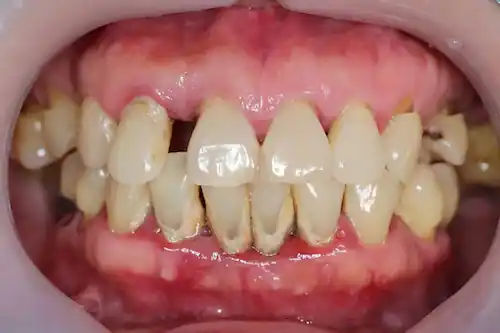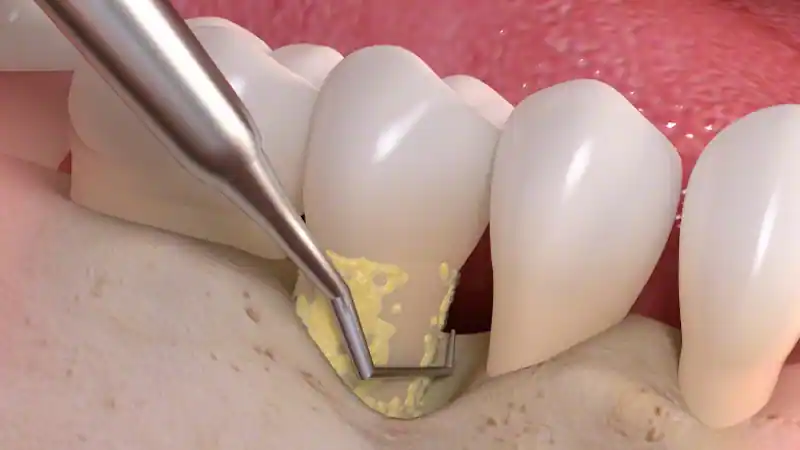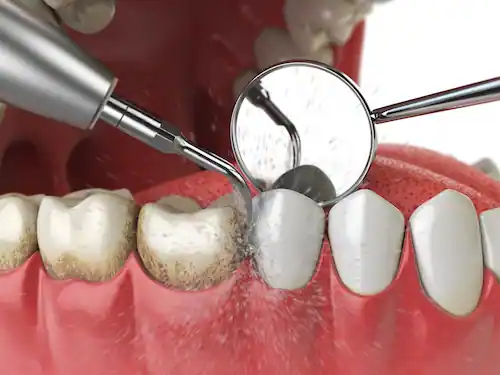Deep cleaning, also known as periodontal scaling and root planing, is a specialized dental procedure performed by dentists or dental hygienists to treat gum disease or periodontitis. It is a more extensive and thorough cleaning compared to a regular dental cleaning (prophylaxis) that is typically performed during routine dental check-ups.
The purpose of a deep cleaning is to remove plaque, tartar (calculus), and bacteria that have accumulated below the gumline and around the roots of the teeth. These deposits can lead to inflammation and infection of the gums, causing gum disease if left untreated. Deep cleaning helps to eliminate the bacterial buildup and restore the health of the gums.
Step-by-step breakdown of what typically happens during a deep cleaning procedure
- Examination: Before the deep cleaning begins, the dentist or dental hygienist will perform a comprehensive examination of your teeth and gums. They may take dental X-rays to evaluate the condition of the supporting structures of your teeth, such as the bone.
- Numbing: Deep cleaning can be uncomfortable, so local anesthesia may be administered to numb the area being treated. This helps to ensure your comfort throughout the procedure.
- Scaling: The first part of the deep cleaning involves scaling, which is the removal of plaque and tartar from the surfaces of the teeth and below the gumline. The dentist or hygienist will use special dental instruments called scalers or ultrasonic devices to scrape away the deposits. The process may involve both manual scaling with handheld instruments and ultrasonic scaling that uses high-frequency vibrations to dislodge the deposits.
- Root Planing: After scaling, root planing is performed. This process involves smoothing out the rough surfaces of the tooth roots to discourage the reattachment of bacteria and help the gums reattach to the teeth. It is done using the same dental instruments used during scaling.
- Irrigation: Throughout the procedure, water or an antimicrobial solution is used to flush away debris and bacteria. This helps to maintain a clean and sterile environment during the deep cleaning.
- Antibacterial Treatment: In some cases, an antimicrobial agent or antibiotic gel may be applied to the treated areas to further control bacterial growth and promote healing.
- Follow-up: Once the deep cleaning is complete, the dentist or dental hygienist will provide instructions on post-treatment care, including proper oral hygiene techniques, the use of mouthwashes, and scheduling regular follow-up visits for monitoring and maintenance.
It’s important to note that deep cleaning is usually performed in multiple appointments, focusing on specific areas of the mouth each time. This ensures thorough treatment and reduces discomfort during the procedure.
Additionally, some patients may require additional treatment such as periodontal surgery or ongoing periodontal maintenance visits depending on the severity of their gum disease.
Deep cleaning is a crucial dental procedure to address gum disease and prevent further damage to the gums and supporting structures of the teeth. It helps restore gum health, reduces inflammation, and promotes optimal oral hygiene.
Things to consider about Deep Cleaning
- Patient Comfort: Dentists understand that deep cleaning can be an intensive procedure, so they prioritize patient comfort throughout the process. They may use topical numbing agents to minimize discomfort during the administration of local anesthesia. Additionally, dentists may provide sedation options for patients with dental anxiety or for more complex cases.
- Follow-up and Maintenance: After deep cleaning, it’s crucial to follow the dentist’s instructions for at-home care and attend regular follow-up appointments. Maintaining good oral hygiene practices, including brushing twice a day, flossing daily, and using antimicrobial mouthwashes, can help prevent further gum disease and maintain the results of the deep cleaning.
- Potential Discomfort: While local anesthesia is used to numb the area, some patients may experience mild sensitivity or discomfort following the deep cleaning procedure. This is normal and should subside within a few days. Over-the-counter pain relievers can help manage any temporary discomfort.
- Benefits of Deep Cleaning: Deep cleaning offers several benefits beyond treating gum disease. It can help prevent tooth loss by preserving the health of the supporting structures of the teeth, such as the gums and bone. Deep cleaning can also improve overall oral health, as gum disease has been linked to various systemic conditions, including heart disease, diabetes, and respiratory issues.
- Periodontal Maintenance: In cases where gum disease is more advanced or recurring, patients may require periodontal maintenance visits following the deep cleaning procedure. These visits involve regular monitoring of the gum health, scaling, and root planing as necessary to keep the gum disease under control.
- Customized Treatment Plans: The deep cleaning procedure is tailored to each patient’s specific needs. The extent and severity of gum disease, as well as the individual’s oral health condition, are taken into consideration when planning the treatment. Dentists may recommend additional procedures or treatments, such as antibiotic therapy or gum surgery, depending on the specific situation.
- Prevention and Early Intervention: Regular dental check-ups are essential for the early detection and prevention of gum disease. Dentists can identify early signs of gum disease, such as gingivitis, and provide appropriate interventions, including professional cleanings and oral health education, to prevent the progression to more severe periodontitis.
Deep Cleaning and periodontal disease
Deep cleaning plays a crucial role in managing and treating periodontal disease. Periodontal disease, commonly referred to as gum disease, is a progressive condition caused by the bacteria present in plaque. When left untreated, it can lead to significant damage to the gums, tooth loss, and even affect overall oral health.
The primary cause of periodontal disease is the buildup of plaque and tartar on the teeth. Regular brushing and flossing can remove plaque from the visible surfaces of the teeth, but it can be challenging to reach the plaque and tartar that accumulates below the gumline. This is where deep cleaning comes into play.
During a deep cleaning procedure, the dentist or dental hygienist uses special instruments to remove the accumulated plaque and tartar from both the surfaces of the teeth and the roots. This process, known as scaling, helps eliminate the bacteria and toxins that have caused the gums to pull away from the teeth, forming pockets. If left untreated, these pockets can become even deeper, providing a favorable environment for further bacterial growth.
Root planing is the next step in a deep cleaning procedure. It involves smoothing the rough surfaces of the tooth roots to discourage the accumulation of plaque and tartar. By making the roots cleaner and smoother, it becomes easier for the gums to reattach to the teeth, promoting healing and preventing the progression of periodontal disease.
Deep cleaning, therefore, plays a crucial role in breaking the cycle of periodontal disease. By eliminating the bacteria, plaque, and tartar that contribute to gum disease, deep cleaning helps reduce inflammation, control infection, and restore gum health. Regular deep cleanings, along with proper oral hygiene practices at home, can significantly improve the management and long-term outcomes of periodontal disease.
It is important to note that deep cleaning is typically recommended for individuals who have been diagnosed with periodontal disease or have significant buildup of plaque and tartar. Regular dental check-ups and cleanings can help detect early signs of gum disease, allowing for prompt intervention and preventive measures to maintain optimal oral health.

Unveiling the hidden threat: the surprising prevalence of periodontal disease and the vital role of scaling and root planing
Surprisingly, numerous individuals can harbor periodontal disease without even realizing it! The occurrence of chronic periodontal disease is attributed to the bacteria in plaque, which causes the gums to recede from the teeth. Consequently, substantial pockets develop between the teeth and gums, fostering the growth of unreachable bacteria that regular brushing at home cannot eliminate.
A recent report from the CDC reveals intriguing statistics regarding the prevalence of periodontitis in the United States. Among adults aged 30 years and above, approximately 47.2% exhibit some form of periodontal disease. Notably, the incidence of periodontal disease escalates with age, with a staggering 70.1% of adults aged 65 years and older affected by this condition.
For patients suffering from chronic periodontitis, scaling and root planing prove highly advantageous as they effectively remove plaque and tartar buildup from both the teeth and roots. Prior to the procedure, the area is numbed to ensure comfort, after which the periodontist proceeds to access the root surface to eradicate plaque, bacterial toxins, and tartar.
Subsequently, root planning is employed to smoothen any rough patches on the surfaces of the roots, thereby averting the accumulation of future bacteria and plaque beneath the gumline. This enables the gums to heal properly and reattach to the tooth.
Nonetheless, numerous individuals fail to detect any symptoms associated with periodontal disease. Therefore, it often comes as a surprise when a dentist recommends scaling and root planing instead of a regular cleaning. It is crucial to comprehend the significance of this procedure in effectively managing periodontal disease and preventing future tooth loss, although additional treatments such as surgery may be necessary to address the disease.
Periodontal maintenance: essential care for lasting oral health
Following a deep cleaning or periodontal surgery, the importance of regular maintenance visits cannot be overstated. These visits play a crucial role in preserving the health of your gums and preventing the recurrence of gum disease, and are commonly referred to as “periodontal maintenance care.”
For optimal oral health and the protection of your teeth and gums, it is recommended that patients schedule periodontal maintenance appointments every three months. However, the specific intervals may vary depending on the individual condition of your gums.

Once diagnosed with periodontal disease and having undergone scaling and root planing, periodontal maintenance assumes the role of prophylaxis in your dental care routine. Unlike prophylaxis, which primarily focuses on the crowns of your teeth, periodontal maintenance extends its care to your tooth roots, gums, and underlying bone.
In essence, it provides thorough cleaning and maintenance for the tissues affected by your periodontal disease. The frequency of your periodontal maintenance appointments will be determined by your dentist based on your unique oral health condition.
At Dental & Implant Centers Of Colorado, rest assured that you will receive exceptional care regardless of the type of cleaning you require. Our team of experienced dental health experts is dedicated to ensuring your oral health is at its best, leaving you feeling confident and satisfied. Contact us today to schedule an appointment and experience our top-quality services.





